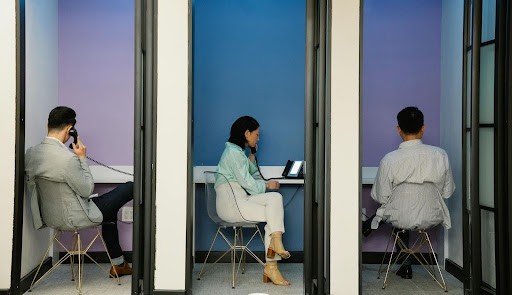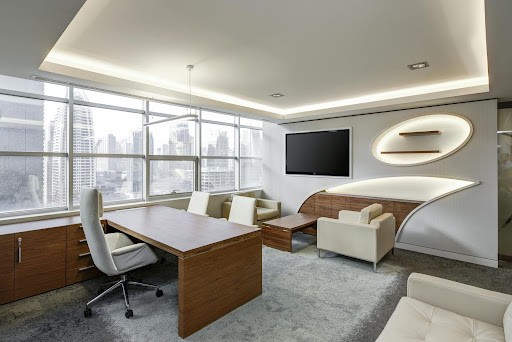
What Is A Cubicle: Meaning + Your Guide In 2025
Does your office space need some reorganization in 2025? Have you considered rearranging or installing cubicles? If so, ROSI Office Systems might be the solution for you.
But what exactly is a cubicle? How do they compare to offices or workstations? What should you know about their dimensions? Do they still fit within the office design trends in 2025?
A cubicle is a partially enclosed workspace separated by low walls, designed to give employees their own area within a larger office environment. In 2025, modern cubicles often feature flexible layouts, ergonomic furniture, and subtle partitions that balance privacy and collaboration—providing comfort, productivity, and efficient use of space.
What Does “Cubicle” Mean?
A cubicle is a partially enclosed workspace designed to provide employees with their personal space within a larger office.
Unlike a private office which is technically a fully enclosed room, a cubicle is open-ended with cubicle walls as physical barriers. These walls typically separate one workspace from another.
Cubicle walls can vary in height, material, and design. They fit within the aesthetics and functionality of the office.
Cubicles became popular in the 1960s, thanks to designer Robert Propst. Today, their designs have considerably evolved. While traditional were boxy and uniform, modern cubicles emphasize flexibility, ergonomic features, and a balance between privacy and collaboration.
A cubicle is the middle ground between an open office and a private one. They maximize space efficiency while giving employees a sense of privacy.
What Is the Difference Between a Cubicle and an Office?
The key differences between a cubicle and an office lie in structure, cost, and purpose.
1. Structure and Layout
A private office is a fully enclosed room, typically with walls that stretch from floor to ceiling and a door for full separation. This setup provides the highest level of privacy. It makes it ideal for managerial roles or positions that would require confidential conversations.
On the other hand, cubicles are defined by their cubicle walls. Their walls don’t extend to the ceiling and usually lack a door. Cubicles provide physical barriers to reduce distractions while maintaining a sense of openness.
Speaking of structure and layout, you might also be interested in how to find the best office desk setup.
2. Cost Efficiency
Private offices typically require more square footage and construction. This makes them more expensive to build or install. These products are a cost-effective alternative that optimizes office space without sacrificing employee productivity.
3. Purpose
Private offices are best suited for roles that demand confidentiality or solitude. Cubicles excel in environments where teamwork is encouraged but employees still need a sense of privacy to focus on their responsibilities.
What Is the Difference Between a Cubicle and a Workstation?
The terms “cubicle” and “workstation” are sometimes used interchangeably, but they’re not exactly the same. Cubicles are enclosed on three or more sides by cubicle walls.
This creates a semi-private workspace. As we mentioned earlier, a cubicle is ideal for the type of work that needs both collaboration and privacy.
Workstations, however, are usually open desk setups without walls. These are more common in open-plan offices where collaboration and visibility are key priorities. While workstations foster communication, they can lack the sense of privacy that many employees need for focused tasks.
When it comes to employee comfort, a cubicle provides a dedicated personal space where an employee can store belongings, personalize their environment, and focus on their tasks without constant interruptions.
In 2025, many companies are opting for modular solutions that blur the line between cubicles and workstations, combining the best features of both.
On a related note, here is how to choose the right desk for your office setup.
What Is the General Cubicle Size?
- Small: Typically 6’ x 6’, these are compact spaces designed for individual tasks that don’t require a lot of equipment.
- Medium: Measuring around 8’ x 8’, these offer more room for additional equipment, shelving, or filing cabinets.
- Large: At 12’ x 12’ or larger, these are often used by managers or team leads who need extra space for meetings or additional storage.
- Custom: A custom cubicle is designed to fit the specific needs of a workspace. They have tailored dimensions for optimal use of office space while enhancing employee comfort and productivity.
In 2025, many companies are opting for adjustable or modular cubicle walls that can adapt to different privacy needs. Higher walls provide more level of privacy, while lower walls foster collaboration.
Why Are Cubicles Still Relevant in 2025?
Yes, they are still very much relevant in 2025, and here is why:
- Flexibility and Customization: Modern cubicles are adaptable and customizable. They offer solutions that can be tailored to the needs of the organization.
- Employee Comfort and Productivity: Personal space directly impacts productivity and morale. A well-designed cubicle should have a sense of privacy, reduce distractions, and create a comfortable and focused space.
- Efficient Use of Space: Cubicles make the most of available office space while still giving employees a dedicated area to work. Office efficiency is especially valuable for companies looking to optimize costs without compromising functionality.
- Balancing Privacy and Collaboration: A modern one is a perfect balance between privacy and teamwork. Employees can focus on individual tasks while still feeling connected to their team.
Would You Like to Know More About Cubicles?
If you are in Houston, Austin, San Antonio, and Stafford, looking for office furniture, call ROSI Office Systems. Our products range from modern desks and ergonomic chairs to the installation of new and used office cubicles in Houston.
Cubicles have come a long way since their inception. Modern ones play a considerable role in today’s office layout and design. They are cost-effective and highly customizable. And of course, this product is a perfect blend of functionality, flexibility, and employee comfort.

John Ofield is a recognized expert in the office furniture and office cubicle industry, with over 40 years of experience. As the founder of ROSI Office Systems, he specializes in space planning, custom cubicle designs, and high-quality commercial furniture. John’s expertise helps businesses enhance productivity and collaboration. He is also dedicated to mentoring entrepreneurs and redefining workspaces to inspire success.






